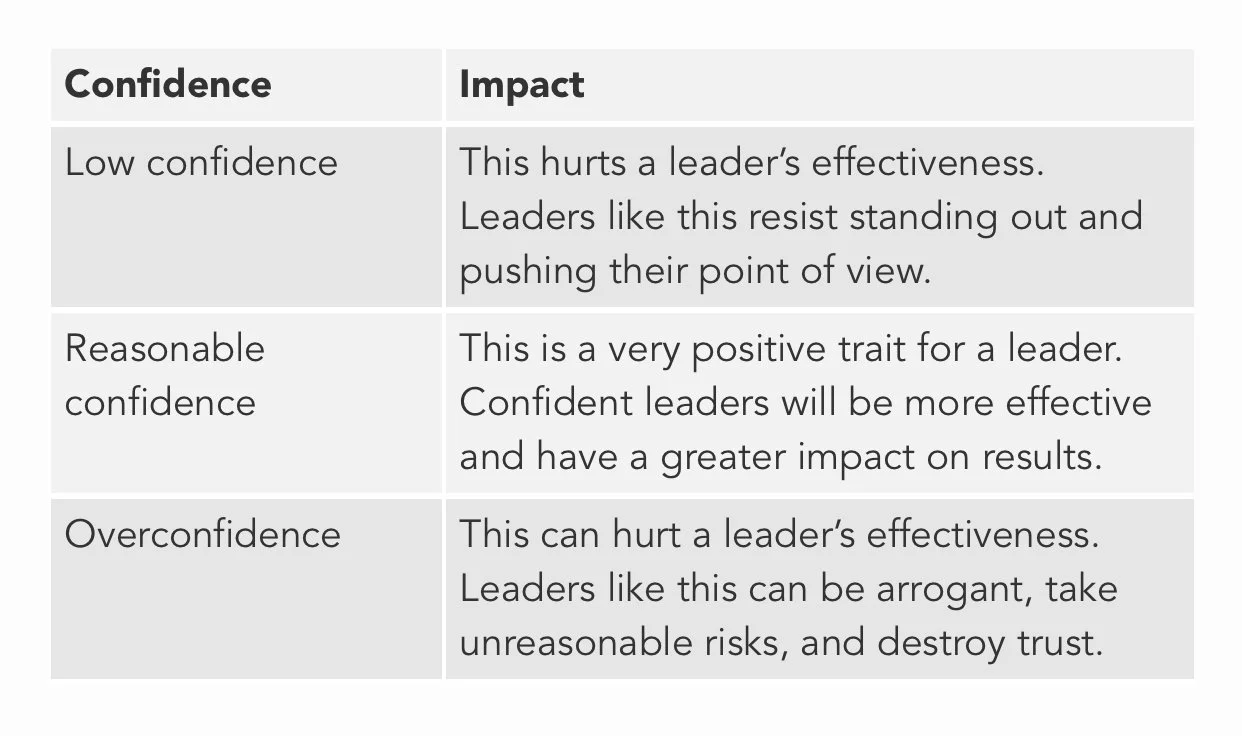How Self-Confidence Can Help Or Hurt Leaders
You might know someone who tends to step back and avoid the spotlight. This kind of person might have difficulty leading a team. On the other hand, you might know a person who is so confident that they take unnecessary risks and may seem arrogant. That person might enjoy being a leader but alienate and frustrate direct reports. Is self-confidence helpful or damaging to a leader?
To understand more about the impact of self-confidence my colleague Jack Zenger and I conducted a study where we had individual leaders rate their self-confidence using a 10-item index. We then connected that assessment with evaluations from The Extraordinary Leader 360-degree assessment. We matched 693 cases where overall leadership effectiveness was assessed by all evaluators and 623 cases where overall leadership effectiveness was rated by the manager of the person receiving the 360-degree assessment. Overall leadership effectiveness is the overall average of 49 differentiating behaviors assessing leadership effectiveness. The graph below shows the results of the study. Note there was a statistically significant improvement in leadership effectiveness as leaders increased in confidence for both all evaluators and the manager’s rating of effectiveness (F = 4.032, Sig. 0.003 for all evaluators, F = 2.936, Sig. 0.020 for manager).
The results from this study seem to validate that self-confidence is a beneficial trait for leaders. Notice in the graph above that the lack of self-confidence has more of a negative effect than high self-confidence has a positive effect. In other words, self-confidence seems to pull overall leadership effectiveness down more than it pushes it up.
What leadership traits are positively effected by high self-confidence?
Looking more closely at the data we discovered that self-confidence has a positive influence on some behaviors, but a neutral or negative influence on others. Those leaders with higher self-confidence were rated significantly more positively on the following six leadership traits.
Being a Champion. High confidence leaders were more willing to be a champion for projects or programs. They did an excellent job of marketing what they did and persuading others to accept a new position.
Having the Courage to Change. High confidence leaders were rated as being more courageous and willing to make bold changes. They were quick to spot problems and recognized the need to change early.
More Energy and Enthusiasm. Leaders with high self-confidence were evaluated as having more energy and the ability to energize others. They were also more of an enthusiast.
Willing to Challenge. High confidence leaders were more likely to challenge standard approaches and encourages others to find new, more innovative ways to do work.
Inspiring. High confidence leaders were rated as being more inspiring. They had the ability to motivate others, and their approach was more pull than push.
Representing the Group. The high confidence leaders were rated significantly higher on their ability to represent their group to other groups or to customers.
These are all very positive traits. In fact, out of 33 of the 49 behaviors we measured, self-confidence had a significantly positive impact. There were, however, 9 behaviors where there was a slightly negative impact associated with self-confidence. When high confidence becomes overconfidence these negative traits emerge.
Lack of Trust. Being over confident can diminish trust from others.
Arrogance. Often the over confident will resist feedback and personal change.
Damaged Relationships. Often the over confident will not notice or be concerned with others. Others often feel that they are taken advantage of or used.
Honesty and Integrity. The over confident fail to honor their commitments and are poor role models.
Some people believe that a strength pushed too far can become a weakness. In most cases with leadership competencies we believe that is not true. A person can’t be too honest, inspiring, or strategic. Developing profound strengths in most competencies is very beneficial to leaders. Confidence looks like a trait where pushing it too far can make it become a weakness. Perhaps too much confidence becomes arrogance and that is a state where it begins to hurt a leader’s effectiveness.
For most people the problem is not overconfidence; it is the lack of confidence. What has become clear to us in helping leaders develop is that focusing on building strengths is a substantially better approach at building confidence. Pointing out only weaknesses tends to diminish confidence. When people take something they do well and improve it, that helps to increase confidence.
Overconfidence Test
If you feel you might be over confident, ask several people to anonymously respond to the following questions:
Am I trusted by others?
Do I ask others for candid feedback on what I can do to improve?
When I ask for feedback, do I make a real effort to change?
Am I in touch with the issues and concerns of others?
Am I balancing getting results with the needs and concerns of others?
Do I follow through on commitments and keep promises?
Am I a role model?
This will give you a good idea about how others perceive your level of confidence. There is a clear line between confidence and arrogance. Aakanksha Kesarwani wisely put, “ When you’re confident, it’s like, ‘I can do this.’ But when you’re proud, it’s like, ‘only I can do this.’” How confident are you?




